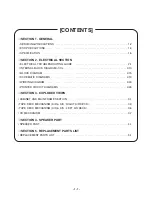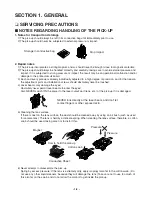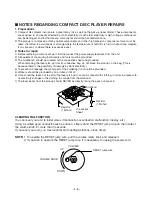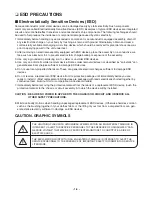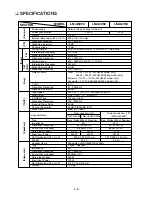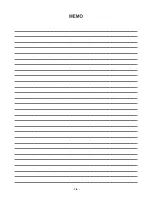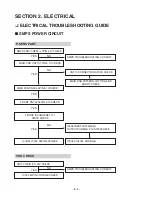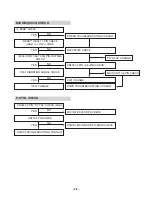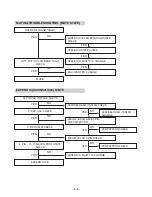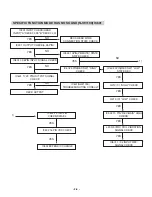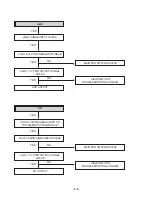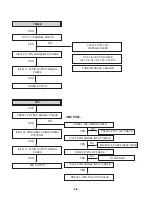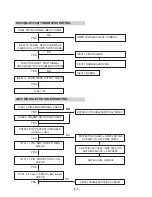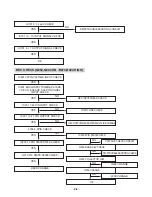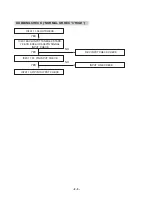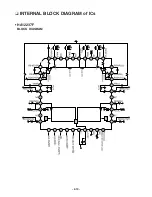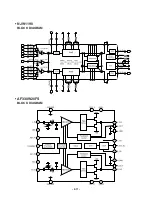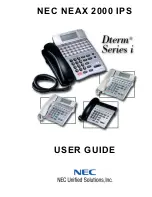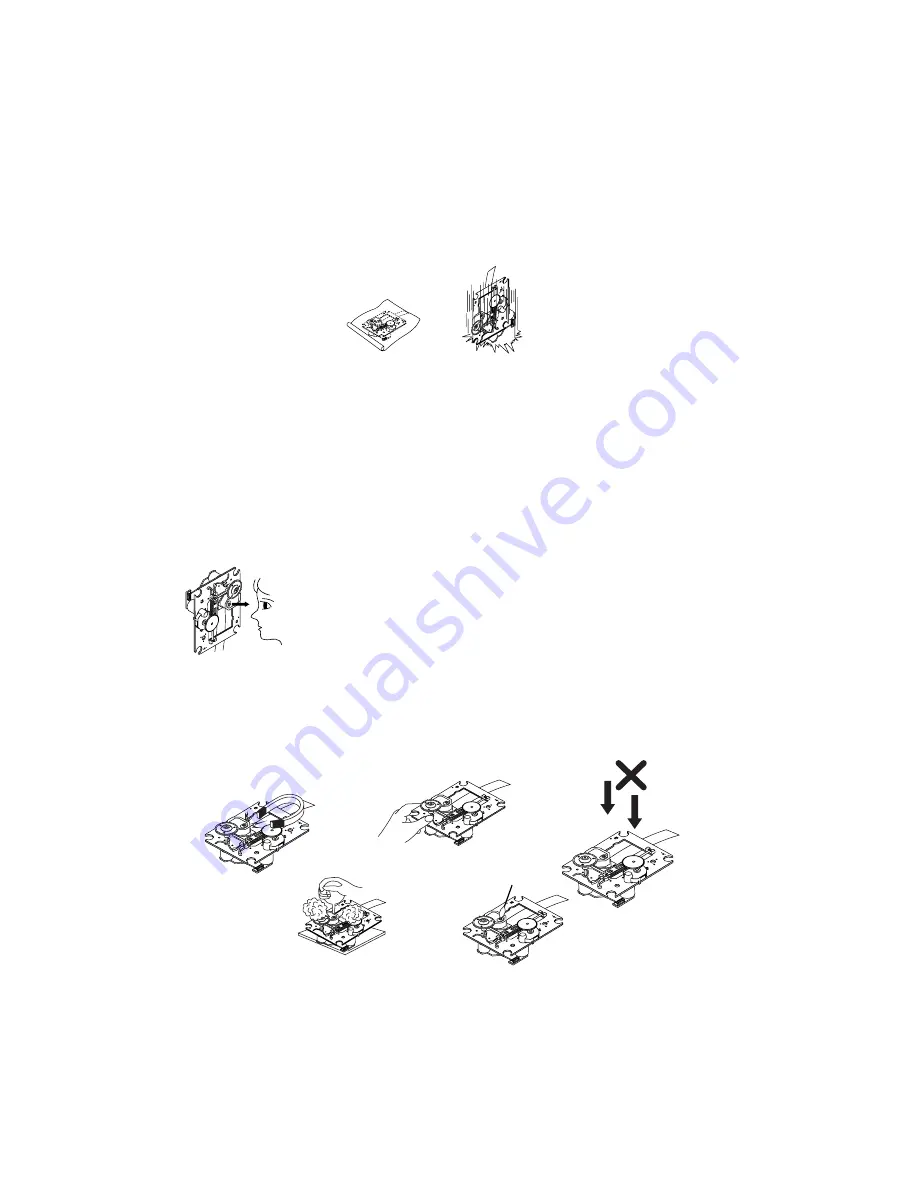
- 1-2 -
SECTION 1. GENERAL
❏
SERVICING PRECAUTIONS
■
NOTES REGARDING HANDLING OF THE PICK-UP
1. Notes for transport and storage
1) The pick-up should always be left in its conductive bag until immediately prior to use.
2) The pick-up should never be subjected to external pressure or impact.
2. Repair notes
1) The pick-up incorporates a strong magnet, and so should never be brought close to magnetic materials.
2) The pick-up should always be handled correctly and carefully, taking care to avoid external pressure and
impact. If it is subjected to strong pressure or impact, the result may be an operational malfunction and/or
damage to the printed-circuit board.
3) Each and every pick-up is already individually adjusted to a high degree of precision, and for that reason
the adjustment point and installation screws should absolutely never be touched.
4) Laser beams may damage the eyes!
Absolutely never permit laser beams to enter the eyes!
Also NEVER switch ON the power to the laser output part (lens, etc.) of the pick-up if it is damaged.
5) Cleaning the lens surface
If there is dust on the lens surface, the dust should be cleaned away by using an air bush (such as used
for camera lens). The lens is held by a delicate spring. When cleaning the lens surface, therefore, a cotton
swab should be used, taking care not to distort this.
6) Never attempt to disassemble the pick-up.
Spring by excess pressure. If the lens is extremely dirty, apply isopropyl alcohol to the cotton swab. (Do
not use any other liquid cleaners, because they will damage the lens.) Take care not to use too much of
this alcohol on the swab, and do not allow the alcohol to get inside the pick-up.
Storage in conductive bag
Drop impact
NEVER look directly at the laser beam, and don’t let
contact fingers or other exposed skin.
Magnet
How to hold the pick-up
Conductive Sheet
Cotton swab
Pressure
Pressure
Summary of Contents for LM-U2350A
Page 7: ... 1 6 ...
Page 17: ... 2 10 INTERNAL BLOCK DIAGRAM of ICs HA12237F BLOCK DIAGRAM ...
Page 18: ... 2 11 NJW1190 BLOCK DIAGRAM AF330W20FS BLOCK DIAGRAM ...
Page 20: ... 2 13 AF350W01FS BLOCK DIAGRAM PIN CONFIGURATION ...
Page 22: ...2 15 2 16 BLOCK DIAGRAM ...
Page 23: ...2 17 2 18 WMA_USB BLOCK DIAGRAM ...
Page 24: ...2 19 2 20 SCHEMATIC DIAGRAMS FRONT SCHEMATIC DIAGRAM ...
Page 25: ...2 22 2 21 MAIN SCHEMATIC DIAGRAM ...
Page 26: ...2 23 2 24 DECK SCHEMATIC DIAGRAM ...
Page 27: ...2 26 2 25 MIC SCHEMATIC DIAGRAM ...
Page 28: ...2 27 2 28 USB_AUX2_H P SCHEMATIC DIAGRAM ...
Page 29: ...2 30 2 29 WOOFER AMP SCHEMATIC DIAGRAM ...
Page 30: ...2 31 2 32 AMP SCHEMATIC DIAGRAM ...
Page 31: ...2 34 2 33 POWER SCHEMATIC DIAGRAM ...
Page 32: ...2 35 2 36 POWER SCHEMATIC DIAGRAM ...
Page 33: ...2 37 2 38 SUB POWER SCHEMATIC DIAGRAM ...
Page 34: ...2 39 2 40 CDP SCHEMATIC DIAGRAM ...
Page 35: ...2 41 2 42 USB SCHEMATIC DIAGRAM ...
Page 36: ...2 43 2 44 WIRING DIAGRAMS ...
Page 37: ... PRINTED CIRCUIT DIAGRAMS MAIN P C BOARD 2 45 2 46 ...
Page 38: ...2 47 2 48 MAIN AMP P C BOARD ...
Page 39: ...2 49 2 50 MAIN AMP P C BOARD ...
Page 40: ...2 51 2 52 FRONT P C BOARD ...
Page 41: ...2 53 2 54 CDP P C BOARD ...
Page 42: ...2 55 2 56 CDP P C BOARD ...
Page 43: ...2 57 2 58 POWER P C BOARD ...
Page 44: ...2 59 2 60 POWER P C BOARD ...
Page 45: ...2 61 2 62 SUB POWER P C BOARD ...
Page 46: ...2 63 2 64 WOOFER AMP P C BOARD ...
Page 47: ...2 65 2 66 ...
Page 55: ... 4 4 ...


